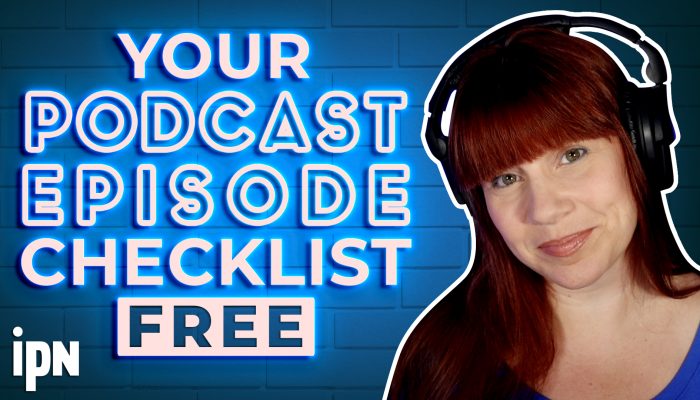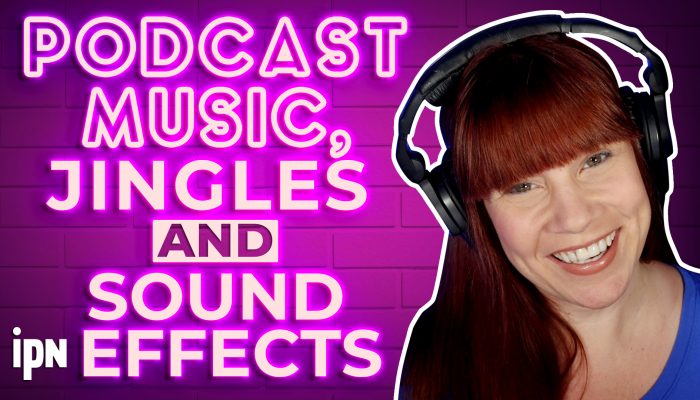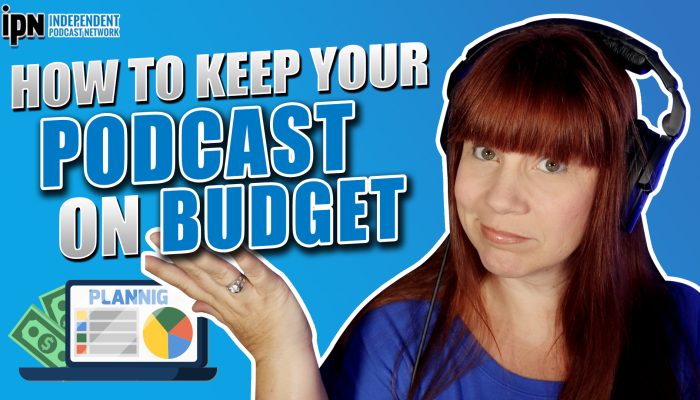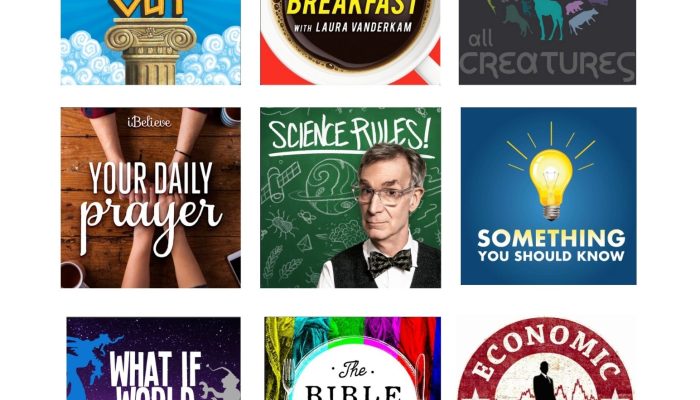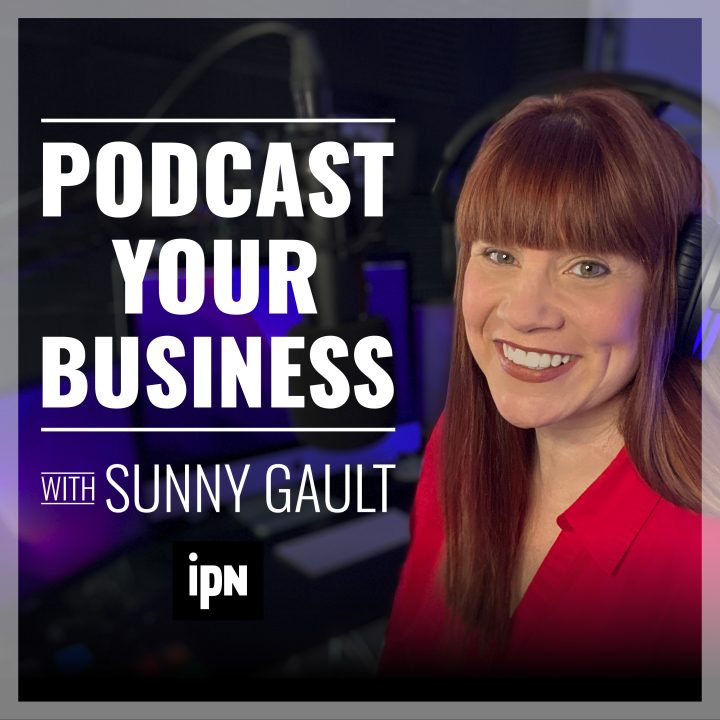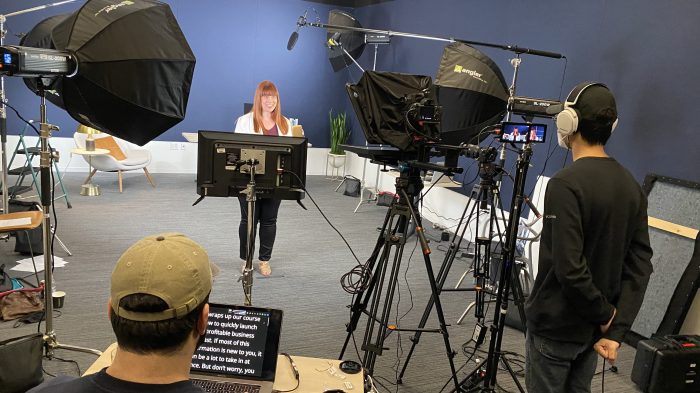
one guest, two guests, three guests, more?
Every podcast has a show format. Your format is what guides your audience through the content. And if you didn’t have a show format, your podcast would be pretty confusing. So, what are your options and how do you know which type of show format to pick? Today you’ll learn how to create a show format for your podcast!
Here’s what we’re talking about today…
- What is a podcast format?
- Audio podcasting versus video podcasting
- The types of podcast formats and their pros and cons
- How to pick the right podcast format
got everything you need for your podcast?
This podcast plan will help you keep track of everything you need to launch your podcast.

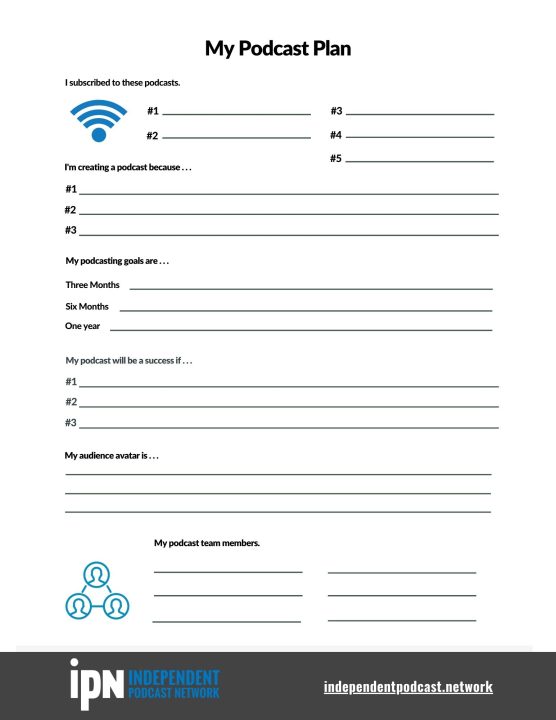
Episode Transcript
0:01
Every podcast has a show format. Your format is what guides your audience through the content. And if you didn’t have a show format, your podcast would be pretty confusing. So what are your options? And how do you know which type of show format to pick? Today you’ll learn how to create this format for your podcast. Take it away, Mr. radio man. Podcast Your Business.
0:33
Hello, everybody. Welcome to another episode of Podcast Your Business. I’m Sunny Gault. I’m a podcast coach and mentor. And I’ve been podcasting for about 17 years now. I’m also the founder and CEO of a company called Independent Podcast Network. We put out a ton of free content, including this podcast every week, including free courses on how to podcast so please check us out at independent podcast dot network. But today, I am here I am your guide to help you create amazing podcast, especially for those of you who are podcasting for your business, hence the name of our podcast. And we do this by mastering the five Ps of podcasting. That’s right, so I talk about the five P’s of podcasting in these podcast courses that I’ve launched for people that are brand new to podcasting, because it can be a little overwhelming at first. And if you want to have a successful podcast, there are certain things that you need to do. And I’ve been able to break these down into five manageable P’s. They are prep, plan, produce, promote, and profit. So prep is all about even deciding if you need a podcast, because just because someone tells you, you should create a podcast, that is not a good reason to start a podcast, podcasting can be a lot of work, right. So that’s the prep part of it. Plan is all about the look and feel for your podcast, how you want it to look, are you doing an audio podcast, video podcasts, all that good stuff. Produce is sometimes the hard part, right, which is creating the content for the show. It is editing, it is recording, all of that promote? How do you tell everyone about it? And then finally, profit? How do you make money? Not everyone wants to make money with their podcasts. But if you’re doing this for your business, somehow it has to impact your bottom line in a positive way. So what way is that? Today, we are going to talk about one of those PS, Mr. radio man, which of the five Ps are we talking about today? Plan.
2:40
That’s right. We’re planning for our podcast today. Because once you determine Yes, I’m going to do this whole podcasting thing, then it’s time to plan and we talk a lot about the format for your podcast, which is what we’re focusing on in today’s episode, creating the right format can literally make or break your podcast, it is super important. And don’t let that Word format. That’s kind of a kind of a big word. Don’t let that intimidate you. Because it’s easier said than done. And I’m going to outline everything for you today. So let’s focus on some of the takeaways that you’re going to have after listening to today’s episode. Here’s what we’re going to talk about, we’re going to answer the question, what is a podcast format? What does that actually mean? When we say the word format? What are we talking about there? We are going to briefly talk about audio podcasting versus video podcasting, because they are very, very different. And that is part of your podcast format. And then we’re gonna get into and this is what the bulk of the episode is going to be. We’re going to talk about the types of podcast formats that you typically see and some of the pros and cons with each. So by the end of this, you should be able to pick which one is going to work best for your podcast. And that leads me to our last little bullet point, which is how do you pick the right format for your podcast? What are some of the things that you should keep in mind? So we will get started with all this right after this quick break? Yay, we’re going to create a format for our podcast. But wait, we have to answer the first question. What is a podcast format? Because it sounds kind of official right? Well, the easiest way to explain this is that this is the way you organize your shows content, right? Because you are going to start a podcast, you already have a podcast, you have to organize your content in some way so that your audience gets it. Keep in mind for those of you who are just doing audio podcast, you are you’re reliant on your listeners to use their ears, right? They don’t have anything visually that they can see. So if you don’t have a format, if you’re all over the place and you’re doing one thing one week and another thing another week, your audience is going to get confused. And then they’re just going to go on to The next podcast because guess what podcasts are free. So it’s really easy. Just to switch from one podcast to another. Obviously, we don’t want that to happen to your show. That’s why we’re talking about this today. Your format gives your show structure so your audience knows what to expect. And it also helps your listeners describe your show to their friends, right? Because we know word of mouth is one of the best ways to share podcast content and to get your podcasts growing. And it’s great for your listeners to share the podcast with other friends. But if they can’t even describe what the show is, if they’re like, oh, it’s about this girl, and well, sometimes she has a gasp, but then other times, it’s just her. And sometimes it’s 10 minutes long. And, you know, other times it’s two hours, it’s way too confusing. Believe it or not, on some level, we’re all creatures of habit. And we just kind of want to know what to expect. So that’s what you need to give your listeners or your viewers if you have a video podcast.
6:02
So that leads me into the next point, let’s talk about audio podcasting versus video podcasting. And we have done a whole episode on podcast your business about this. So I encourage you to go back and check that out. If you haven’t listened to that episode yet. I also have some blog posts and stuff that I can link to. But let’s just do a quick run through right now. The nice thing about video podcasts, and this is a growing thing in podcasting. Now they’re becoming more and more popular. The nice thing is it gives you more opportunities for people to find your content. How many times for those of you who already have an audio podcast, how many times if you wanted to share your podcast on YouTube, or share something that requires some sort of visual that you really don’t have, right, because it’s just an audio podcast. Obviously, you don’t have that with video. And it allows you to expand in theory to a wider audience, you can put your content in more places. I also think video allows people to connect on a deeper level. Now that I’ve said that some of you guys may be like, no, no, no, no, I love my audio podcasts. And I connect with them. So well, you know, I connect with the hosts of the show so well. And I’m sure that that’s true. But when you physically see somebody, it’s just a little bit different, and it’s a little bit more personal. So while I love on your podcast, this is an audio podcast, we don’t do video for this show. I know that for the shows that I do that have video, it’s a completely different experience, there is a stronger connection to the audience, no doubt about it. Okay, what are some of the cons, because there’s, there’s kind of a lot, especially if you’re doing this on your own, it is much more difficult to produce video, don’t let anyone tell you that that’s not the case. Of course, it does depend on the format for your show, which we’re going to talk about in a little bit. But think about your lighting, your lighting has to be good lighting is almost more important than your camera. Because if you have horrible lighting, you won’t even be able to see the person, I don’t care how great your camera is. So you have to think about lighting, you have to think about the person’s background. Is it inappropriate background? Do they have crap all over in the background? Do they have inappropriate things on the wall? What about your guests themselves? Did they bother to comb their hair? Did they put on makeup? What are they wearing? It looks like they just woke up and you know, just got out of bed. Believe it or not this kind of stuff happens. And so creating a video podcast is definitely more challenging. And because of that, it’s going to cost you more money, not just in the production side of it. But the editing as well. There’s just more components to it. And you can’t usually make quite as many edits as you could necessarily with audio. So you also have to be a little bit more on your A game. Because you could you could edit up an audio podcast really easily. But if you ended up doing that with a video podcast, and you had a ton of edits, it would look very choppy. And some choppiness is okay, but a lot of choppiness is not cool. It just looks like you don’t know what you’re doing. So that’s another thing to consider. Also know that you are creating a little bit more work for yourself. Because right now, video podcasts mainly exist on YouTube. So if you’re not already uploading content to YouTube, you’ll probably have to create a YouTube account you can use. It depends on your podcast host provider, some podcast host providers allow you to upload video content to them, some do not. Okay, so the distribution is a little bit different as well. And honestly, podcasting is still trying to figure all this stuff out. It’s still kind of new to video podcasts. We actually had video podcasts many many years ago and then they kind of went away and now they’re coming back. And so all of the podcast players are trying to figure out how to handle video So you’d kind of be new to the game. The good news is, with all of the podcast formats we’re going to talk about today, you can add video to any of these formats. So it’s okay to start with audio. Now even if you think you may go into video, just start with audio. Now, it’s easier, you can get your feet wet, really work on your podcast format, and then add video when you feel more comfortable.
10:20
So let’s talk about some of those podcast formats. We’re gonna go over the top five podcast formats today. The first one is a solo or monologue style. That’s exactly what podcast your businesses, it is just me talking. Yes, I have Mr. radio man coming in every now and again. And honestly, that’s just to have another voice in the podcast because I do like mixing it up a little bit. But this is a solo show. So that’s kind of what you get. So some of the nice things about doing a solo show is that everything happens at your own pace and schedule. Case in point today, I wasn’t sure if I was going to record this now if I was going to wait until tomorrow to do it. And I decided to do it now because I have a little bit of extra energy. But I was basically playing it by ear. The more people you have in your podcast, the less flexibility you have to be able to do something like that. Also, your audience gets a chance to know you personally, because the podcast is pretty much all you. And so that can be a really good thing, especially for those of you who are coaches and mentors. That’s really what you want, right? You want to get more clients through your podcast. And so people feeling connected to you feeling like they could work with you in different ways. And trust you. That’s really important. So some of the cons here are that it’s a lot of talking. Now we are on let’s see, what is this episode 43 For podcast, your business, but I have 17 years of experience in talking on podcast. So I’ve been doing this a while right? It was still, you know, a little bit of a challenge for me in the beginning, these episodes were like maybe 10 to 14 minutes long. And now I struggle to keep it under 30 minutes, I’m just more confident. Now things come to me, you know, easier. Because I’ve done this multiple times, I know some of the hang ups that I have and the pitfalls you know, I can try to avoid, but just know it is going to be a lot of talking. And this is when we get into and we’ve talked about this before. But you know having bullet points or an outline for what you’re going to be talking about. I’m literally looking at an outline right now as I talk to you to make sure I talk about everything I need to talk about. So you know, so if this is new to you, if you’re new to podcasting, you might get a little bit nervous in the beginning that will wear off eventually just know that that’s there. And that’s a real thing when you’re doing a solo or monologue podcast.
12:47
The next format is an interview format. By far, this is the most popular format in podcasting. Now you could have a bunch of people that are part of the interview. But what I’m really talking about is one host and one guest. Now some of the pros, at least this could be viewed as a pro is that the guests do most of the talking. So you are there to set up the structure for the show and to ask questions, you have to do some research, obviously, to know what kind of questions to ask and you need to do research on your guest. But when it’s showtime, it’s pretty much the guest doing most of the talking and you are guiding them. You do get some different opinions and viewpoints because you have someone on your show that is providing different information than what you could give by yourself. So that could be viewed as a pro as well. And when you’re talking with somebody else, I’ve noticed that your audience is more forgiving of mistakes. For some reason, when it’s just one person on a podcast, you listen, maybe it’s you listen a little bit more intently. And you notice all the mess ups a lot more. When you’re listening to two people just talk back and forth. It just sounds like a natural conversation. So people say um, and on stuff like that, it’s okay to leave that in the conversation because it’s like our minds just switch for a little bit. And it’s less of a presentation, or a coaching session, if you will. And it’s more of just two people talking. So guests are more forgiving of mistakes like that your guest that you have on the show may promote the content. So that could be a way to get the word out about your show. Sometimes they do sometimes they don’t. So you can’t necessarily count on that. But that could be a pro. Some of the cons is that, like I said before, this is the primary format that most people pick with their podcasts. So sometimes it’s hard to stand out. And a lot of times these podcasts have the same guests on their shows. So you kind of want to avoid some of those pitfalls. So figure out a way to still stand out. It’s going to take a little bit of time to find the gas to schedule the gas and then what happens if they cancel so keep that in mind as Well, and when you are interviewing someone, it’s usually done remotely through a podcast platform that focuses that specializes in remote recording. And sometimes there’s tech issues, I had this happen to me the other day, I was recording with multiple guests, I think there were like six or seven of us total. So a bunch of people, and one of the guests joined, she joined a little bit late. And I could tell immediately that we were having trouble with her audio recording, like all these error messages were kind of popping up. But we were already running a little bit late on the recording. So I was just crossing my fingers hoping that her audio would record properly. Well, after we were done, I listened and it didn’t record any of her stuff, she just did not have the system requirements to be able to record using that platform. And I had to show to run, I had to proceed forward with the recording. So that’s just one example. Now we had enough other people participating on that call or on that recording. So it was okay, I just had to edit her out like any of the pauses where she was talking, you know, that I didn’t have the file for I just had to edit all that out. But that’s just one more example of having tech issues when you’re recording with more than just yourself. So that’s the interview.
16:19
Next, we have a conversation with some sort of co-host. So you don’t necessarily have guests, but it’s you and somebody else, you have a partner who essentially is responsible for half of the conversation. That’s really how it should be, that’s how a good co host situation should turn out is that no one’s really dominating the conversation. But you’re both bringing really good insight. And, you know, it plays on both of your strengths. And some of the pros with this, as listeners feel like they are a fly on the wall, you know, these are the podcasts that you can just play while you’re doing multiple things in your house. And it’s just entertaining. It’s almost like, you know, when you’re listening to morning radio or something like that in your car, it’s okay, like, if you miss some stuff, it’s not a big deal. But you’re still entertaining them. It’s what we call easy listening, you don’t have to take notes, you’re not trying to find out this ailment that is, you know, plaguing your child, you know, or something like that. This is just very natural and fun and all that good stuff. Now you still have to prep, you still have to coordinate with your other hosts. So there is, you know, some of that is involved, there’s no way to get around that if you want the show to be good. Please, please, please don’t just turn on the podcast microphone and think that you’re going to be entertaining. Just because you’ve got two people, it does not work that way. Unless both of you guys are comedians and even then you’re probably go way off script and you know, go into multiple places, and you need to keep the show on track, you need to have some sort of format. Also, regarding editing, it is harder to edit two tracks as opposed to one track. So whether that’s an interview, whether that is you and your co host, when you get into those really good co host conversations, though, as with any conversation, you start to overlap each other. And that’s when it can get really tricky to edit. So if you’re gonna do that, you may want to hire an outside editor if editing is not your thing.
18:20
All right, next format is a panel. So this would be you have a single host and a group of guests. And for the parenting shows that I do. That is the format, we have a roundtable of guests that join us. Now in our situation, we do have one host, and usually there’s an expert. And then usually there’s like a few other parents joining the conversation. But it’s still a panel conversation, we have a group of gas, the benefits are you have a ton of opinions. So if that’s okay, on your show, if you’re okay with having varying opinions that aren’t your own, that’s great, your audience is going to hear a lot of different things, the guests do most of the talking, you really take on as a host, you take on more of a moderator role. Yes, you can insert your opinion and your experience here and there. But the show is really about the conversation that your guests are having. Now some of the cons is scheduling can be really tough. Like I was just giving you that example with that one guest that didn’t quite have the system requirements. I wasn’t sure if she was going to show up or not. And then she showed up late. So you just never really know, with scheduling and people you know, things come up in people’s lives and they may have to drop off last minute. And then you may have to maybe change your questions because Oh, you’re going to ask that person now but now they’re not part of the conversation. So keep all that in mind. And as a host you must still control the topic like is that you are the moderator. Don’t let them run away with the conversation. You have to maintain control. have that because you are focused on the format, because your audience really needs that. And again, with the technical challenges, I gave that example before, you just never know people, you know, you never know what microphones they’re going to bring. Now, since COVID, a lot of people have at least an external microphone at home. So that has improved. But people’s microphones all sound different, and their recording environment sound different. So if you’re going to record with multiple people, and you’re not going to give them all the same microphone, then know that the audio is just going to sound different in everybody’s place, you have to be okay with that.
20:38
And the final format that we want to talk about today is scripted storytelling. Most of the people listening to this podcast episode probably aren’t going to go into that that’s something I’ve been experimenting with lately. I love doing it. I’ve got a background in journalism. So I love telling people stories, and then editing and sound bites and doing all that kind of stuff. This can be highly addictive, I guess, in a positive way. For listeners, which is why a lot of people do this. So the true crime that everybody is going for in podcasting. Now, this is an example of that scripted storytelling and how people just get addicted to it. And then they listen, they want to hear what’s happening in the next episode, and the next episode, and oh, my gosh, I gotta listen that now I’m gonna binge listen to this whole thing, right? So it’s addictive, it usually costs more money to produce because the larger team is needed, usually one person can’t do everything that’s required. And there’s a lot of research that’s usually involved, especially when you get into that true crime, because you really got to know what you’re talking about, you usually can’t just wing this kind of stuff, you need to know your facts, which means you’ve got to do your research. And it’s going to take time to do that. And usually a bigger team, which costs more money. Okay, so those are your five formats, solo/monologue, interview, just one host and one guest, a conversation between you and a co host, a panel where you have a single host, and then a group of guests. And then scripted storytelling, which obviously requires more research and sound bites, multiple interviews, voiceover, and all that fun stuff. So those are your five main podcast formats. And once you figure that out, you can get a little bit more granular, because I do think you should plan out your episodes a little bit more with what I like to call your podcast structure. And that’s all about segments, you’ve got your show intro, you’ve got your content, maybe you have additional segments you want to do to get the audience involved. You’ve got commercial spots, and you have your show outro. So maybe we’ll do an entirely separate episode just about podcast structure, because there’s a lot to talk about there. But I didn’t want to overwhelm you guys today. All of this is related to your shows format.
22:58
So how do you pick the right podcast format? First, you need to know who your podcast avatar is? Who are you planning to reach to keep in mind that can be a little bit different than who you actually end up reaching? I’ve had that happen with podcasts as well. But know who you’re trying to reach out to? What is the message that you’re trying to convey? Who are you trying to reach? And what is the best way to reach them? When I was planning out my podcast for parents, I really thought about, well, are parents going to want a video podcast because I don’t have time to just sit around and watch a 30 to 45 minute video. Maybe an audio format is best. So parents can multitask at the same time. So that’s just one example. That’s why you have to know who you’re talking to. What is their schedule? Like? What is the best way to convey the topics that you’re planning to talk about? Because sometimes, topics need visuals. And that makes them not the best unless you’ve got a video podcast. One example would be I wanted to do this episode for the parenting shows that was all about car seat safety and how to buckle your kids properly into a car seat. That is a very visual topic. Now I could have a car seat expert on to talk about the importance of car seat safety and where to go to get things checked and all that kind of stuff. But physically showing people I actually had to do a separate video and tell people hey, we did this video if you want to see what we’re talking about right now. So sometimes it just doesn’t work. But if you know that a lot of the topics that you want to talk about are visual, then maybe you really do need to do a video podcast. Also think about what’s going to help your show standout. As I mentioned earlier, a lot of people pick that interview format. And as a result, sometimes it’s hard for those podcasts to stand out. Now there are obviously really popular podcasts that have that interview format, but there’s a lot that you never hear about that just kind of pod fade, because they couldn’t figure out how to make themselves different and appear different and special and unique from all the other shows out there. So consider that as well. And for those of you who are doing this for your business, you always need to bring it back to your brand, your style, what makes the most sense for your business, and what you’re trying to accomplish through your podcast. So hopefully, all of that helped you guys, I do have some more free information for you on the other side of this commercial break.
25:37
Today, we’ve been talking about finding the best format for your podcast. And I do talk about this a little bit in this handout that I created. And it’s called Create a Plan for your Podcast. And it covers a lot of different things format is one of the things that we talk about in this and I would love to give this to you for free. This is a great Planning Guide. For those of you who are starting your podcast fresh, but even if you’ve already created your podcast and you want to make sure you checked all the boxes. This can definitely help you out with that. So download it. It’s free, so why not write also check out our website https://independentpodcast.network. Free courses, free blog posts, more podcast episodes just like this one videos, free handouts. Just a ton of free stuff. Check it out Independent Podcast Network. Until next week, remember you should start a podcast!
